Effect of Electrochemical Pre-Oxidation for Mitigating Ultrafiltration Membrane Fouling Caused by Extracellular Organic Matter
Abstract
1. Introduction
2. Materials and Method
2.1. EOM Extraction
2.2. Experimental Protocal
2.3. Membrane Fouling Assessment
2.4. Analytical Methods
3. Results and Discussion
3.1. Effect of Electrochemical Pre-Oxidation on Membrane Fouling Reversibility
3.2. Effect of Electrochemical Pre-Oxidation on Foulant Property
3.3. Effect of Electrochemical Pre-Oxidation on Separation Performance
4. Conclusions
- (1)
- BDD anodic oxidation can effectively alleviate the membrane flux decline and irreversible membrane fouling by oxidizing and removing organic substances in EOM, and the critical blocking is gradually replaced by the standard blocking as the oxidation time increases;
- (2)
- BDD anodic oxidation can increase the zeta potential of EOM and interfacial free energy, which promotes the destabilization and sedimentation of the EOM solution;
- (3)
- Electrochemical pre-oxidation and ultrafiltration processes both have excellent removal performance for the disinfection by-product precursors.
Author Contributions
Funding
Data Availability Statement
Conflicts of Interest
References
- Fang, J.Y.; Yang, X.; Ma, J.; Shang, C.; Zhao, Q.A. Characterization of algal organic matter and formation of DBPs from chlor(am)ination. Water Res. 2010, 44, 5897–5906. [Google Scholar] [CrossRef] [PubMed]
- Qu, F.S.; Liang, H.; He, J.G.; Ma, J.; Wang, Z.Z.; Yu, H.R.; Li, G.B. Characterization of dissolved extracellular organic matter (dEOM) and bound extracellular organic matter (bEOM) of Microcystis aeruginosa and their impacts on UF membrane fouling. Water Res. 2012, 46, 2881–2890. [Google Scholar] [CrossRef] [PubMed]
- Gao, K.; Li, T.; Zhao, Q.Q.; Liu, W.; Liu, J.X.; Song, Y.L.; Chu, H.Q.; Dong, B.Z. UF fouling behavior of allelopathy of extracellular organic matter produced by mixed algae co-cultures. Sep. Purif. Technol. 2021, 261, 11. [Google Scholar] [CrossRef]
- Guo, W.S.; Ngo, H.H.; Li, J.X. A mini-review on membrane fouling. Bioresour. Technol. 2012, 122, 27–34. [Google Scholar] [CrossRef]
- Villacorte, L.O.; Tabatabai, S.A.A.; Anderson, D.M.; Amy, G.L.; Schippers, J.C.; Kennedy, M.D. Seawater reverse osmosis desalination and (harmful) algal blooms. Desalination 2015, 360, 61–80. [Google Scholar] [CrossRef]
- Henderson, R.K.; Baker, A.; Parsons, S.A.; Jefferson, B. Characterisation of algogenic organic matter extracted from cyanobacteria, green algae and diatoms. Water Res. 2008, 42, 3435–3445. [Google Scholar] [CrossRef]
- Qu, F.S.; Liang, H.; Wang, Z.Z.; Wang, H.; Yu, H.R.; Li, G.B. Ultrafiltration membrane fouling by extracellular organic matters (EOM) of Microcystis aeruginosa in stationary phase: Influences of interfacial characteristics of foulants and fouling mechanisms. Water Res. 2012, 46, 1490–1500. [Google Scholar] [CrossRef]
- Babel, S.; Takizawa, S. Microfiltration membrane fouling and cake behavior during algal filtration. Desalination 2010, 261, 46–51. [Google Scholar] [CrossRef]
- Her, N.; Amy, G.; Park, H.R.; Song, M. Characterizing algogenic organic matter (AOM) and evaluating associated NF membrane fouling. Water Res. 2004, 38, 1427–1438. [Google Scholar] [CrossRef] [PubMed]
- Huang, H.; Schwab, K.; Jacangelo, J.G. Pretreatment for Low Pressure Membranes in Water Treatment: A Review. Environ. Sci. Technol. 2009, 43, 3011–3019. [Google Scholar] [CrossRef] [PubMed]
- Cheng, X.X.; Liang, H.; Ding, A.; Qu, F.S.; Shao, S.L.; Liu, B.; Wang, H.; Wu, D.J.; Li, G.B. Effects of pre-ozonation on the ultrafiltration of different natural organic matter (NOM) fractions: Membrane fouling mitigation, prediction and mechanism. J. Membr. Sci. 2016, 505, 15–25. [Google Scholar] [CrossRef]
- Wan, Y.; Xie, P.C.; Wang, Z.P.; Ding, J.Q.; Wang, J.W.; Wang, S.L.; Wiesner, M.R. Comparative study on the pretreatment of algae-laden water by UV/persulfate, UV/chlorine, and UV/H2O2: Variation of characteristics and alleviation of ultrafiltration membrane fouling. Water Res. 2019, 158, 213–226. [Google Scholar] [CrossRef] [PubMed]
- Zhu, T.T.; Liu, B. Mechanism study on the effect of peracetic acid (PAA), UV/PAA and ultrasonic/PAA oxidation on ultrafiltration performance during algae-laden water treatment. Water Res. 2022, 220, 11. [Google Scholar] [CrossRef] [PubMed]
- Park, H.; Choo, K.H.; Park, H.S.; Choi, J.; Hoffmann, M.R. Electrochemical oxidation and microfiltration of municipal wastewater with simultaneous hydrogen production: Influence of organic and particulate matter. Chem. Eng. J. 2013, 215, 802–810. [Google Scholar] [CrossRef]
- Qiao, J.; Xiong, Y.Z. Electrochemical oxidation technology: A review of its application in high-efficiency treatment of wastewater containing persistent organic pollutants. J. Water Process. Eng. 2021, 44, 25. [Google Scholar] [CrossRef]
- Yu, X.M.; Zhou, M.H.; Hu, Y.S.; Serrano, K.G.; Yu, F.K. Recent updates on electrochemical degradation of bio-refractory organic pollutants using BDD anode: A mini review. Environ. Sci. Pollut. Res. 2014, 21, 8417–8431. [Google Scholar] [CrossRef]
- Long, Y.J.; Li, H.N.; Xing, X.; Ni, J.R. Enhanced removal of Microcystis aeruginosa in BDD-CF electrochemical system by simple addition of Fe2+. Chem. Eng. J. 2017, 325, 360–368. [Google Scholar] [CrossRef]
- Liu, B.; Zhu, T.T.; Liu, W.K.; Zhou, R.; Zhou, S.Q.; Wu, R.X.; Deng, L.; Wang, J.; Van der Bruggen, B. Ultrafiltration pre-oxidation by boron-doped diamond anode for algae-laden water treatment: Membrane fouling mitigation, interface characteristics and cake layer organic release. Water Res. 2020, 187, 11. [Google Scholar] [CrossRef]
- Liu, B.; Qu, F.S.; Chen, W.; Liang, H.; Wang, T.Y.; Cheng, X.X.; Yu, H.R.; Li, G.B.; Van der Bruggen, B. Microcystis aeruginosa-laden water treatment using enhanced coagulation by persulfate/Fe(II), ozone and permanganate: Comparison of the simultaneous and successive oxidant dosing strategy. Water Res. 2017, 125, 72–80. [Google Scholar] [CrossRef]
- Hermia, J. Constant Pressure Blocking Filtration Laws-Application to Power-Law Non-Newtonian Fluids. Trans. Inst. Chem. Eng. 1982, 60, 183–187. [Google Scholar]
- Ho, C.C.; Zydney, A.L. A combined pore blockage and cake filtration model for protein fouling during microfiltration. J. Colloid Interface Sci. 2000, 232, 389–399. [Google Scholar] [CrossRef] [PubMed]
- Lee, S.J.; Dilaver, M.; Park, P.K.; Kim, J.H. Comparative analysis of fouling characteristics of ceramic and polymeric microfiltration membranes using filtration models. J. Membr. Sci. 2013, 432, 97–105. [Google Scholar] [CrossRef]
- Liu, B.; Qu, F.S.; Liang, H.; Gan, Z.D.; Yu, H.R.; Li, G.B.; Van der Bruggen, B. Algae-laden water treatment using ultrafiltration: Individual and combined fouling effects of cells, debris, extracellular and intracellular organic matter. J. Membr. Sci. 2017, 528, 178–186. [Google Scholar] [CrossRef]
- Zhu, T.; Zhou, Z.; Qu, F.; Liu, B.; Van der Bruggen, B. Separation performance of ultrafiltration during the treatment of algae-laden water in the presence of an anionic surfactant. Sep. Purif. Technol. 2022, 281, 119894. [Google Scholar] [CrossRef]
- Zhu, T.; Qu, F.; Liu, B.; Liang, H. The influence of environmental factor on the coagulation enhanced ultrafiltration of algae-laden water: Role of two anionic surfactants to the separation performance. Chemosphere 2022, 291, 132745. [Google Scholar] [CrossRef]
- Liu, B.; Qu, F.; Yu, H.; Tian, J.; Chen, W.; Liang, H.; Li, G.; Van der Bruggen, B. Membrane fouling and rejection of organics during algae-laden water treatment using ultrafiltration: A comparison between in situ pretreatment with Fe (II)/persulfate and ozone. Environ. Sci. Technol. 2018, 52, 765–774. [Google Scholar] [CrossRef]
- Motsa, M.M.; Mamba, B.B.; D’Haese, A.; Hoek, E.M.; Verliefde, A.R. Organic fouling in forward osmosis membranes: The role of feed solution chemistry and membrane structural properties. J. Membr. Sci. 2014, 460, 99–109. [Google Scholar] [CrossRef]
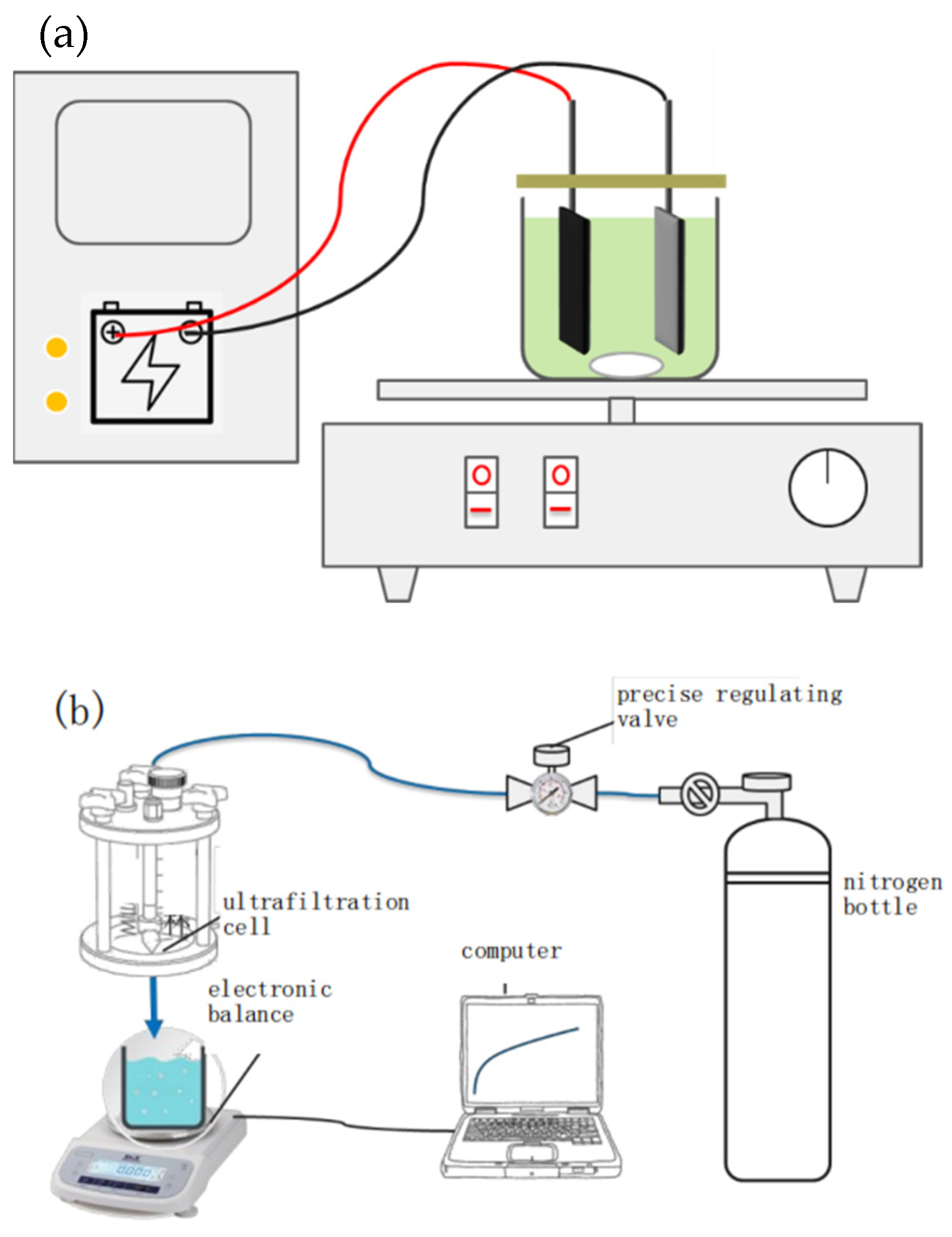
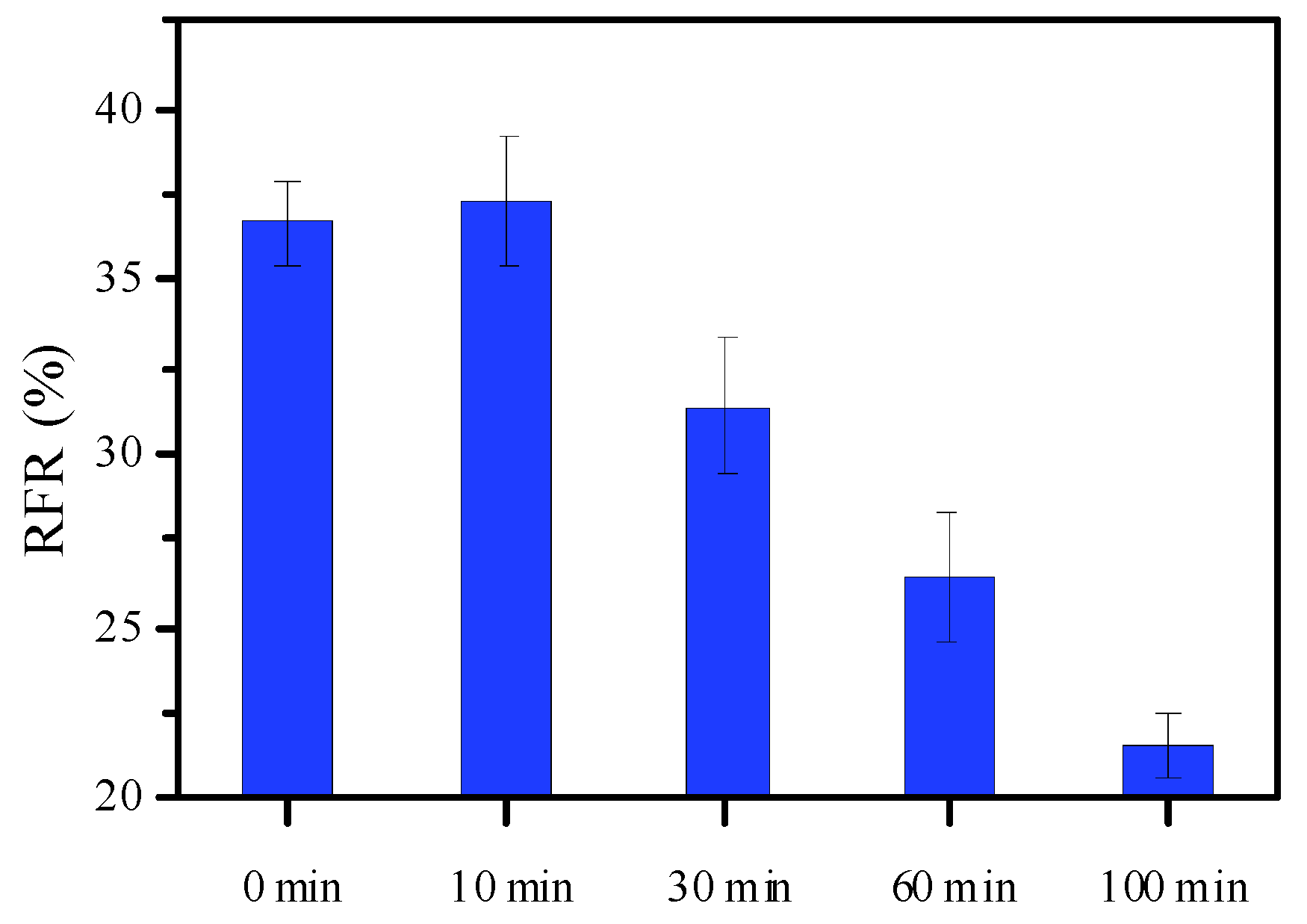
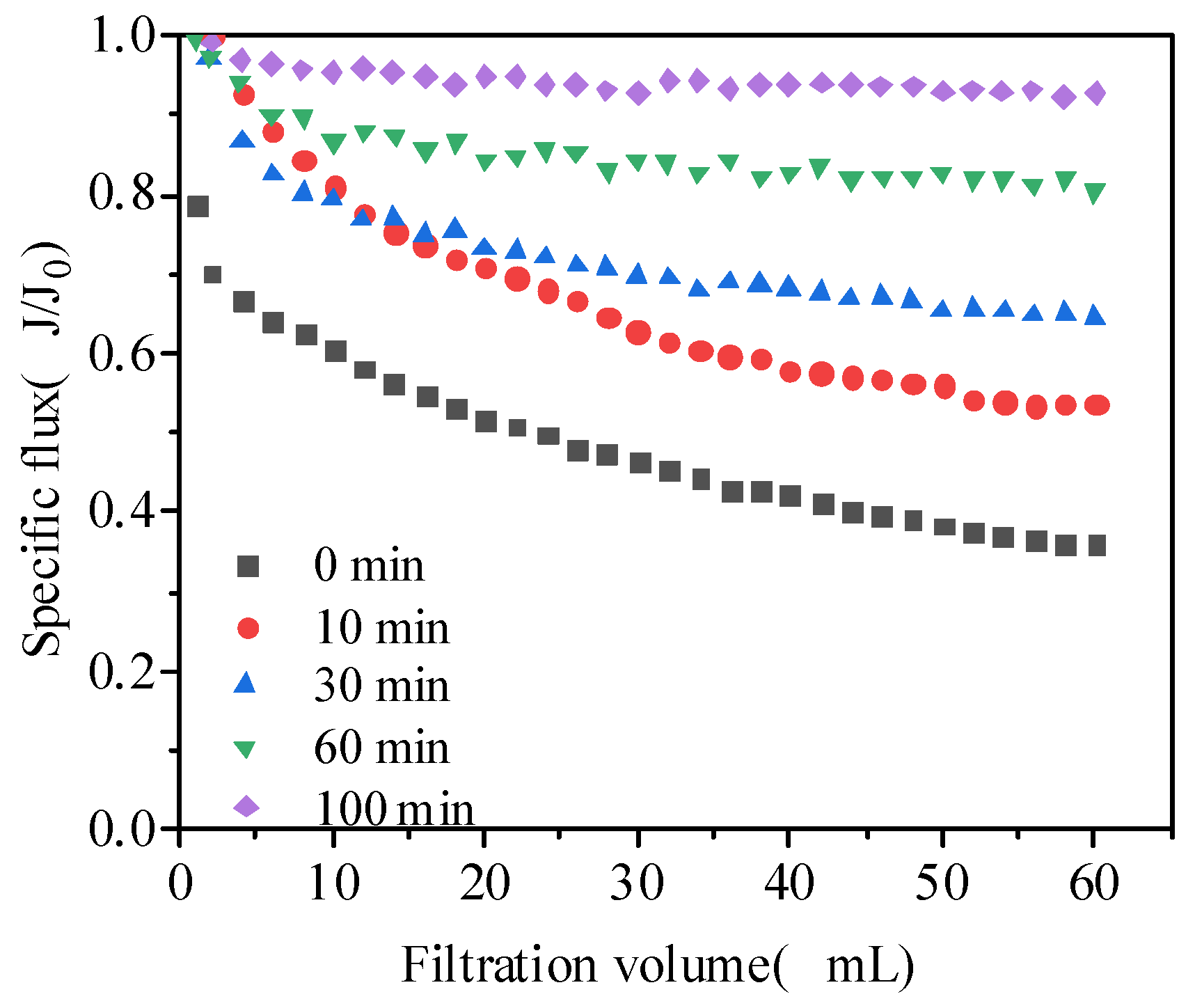

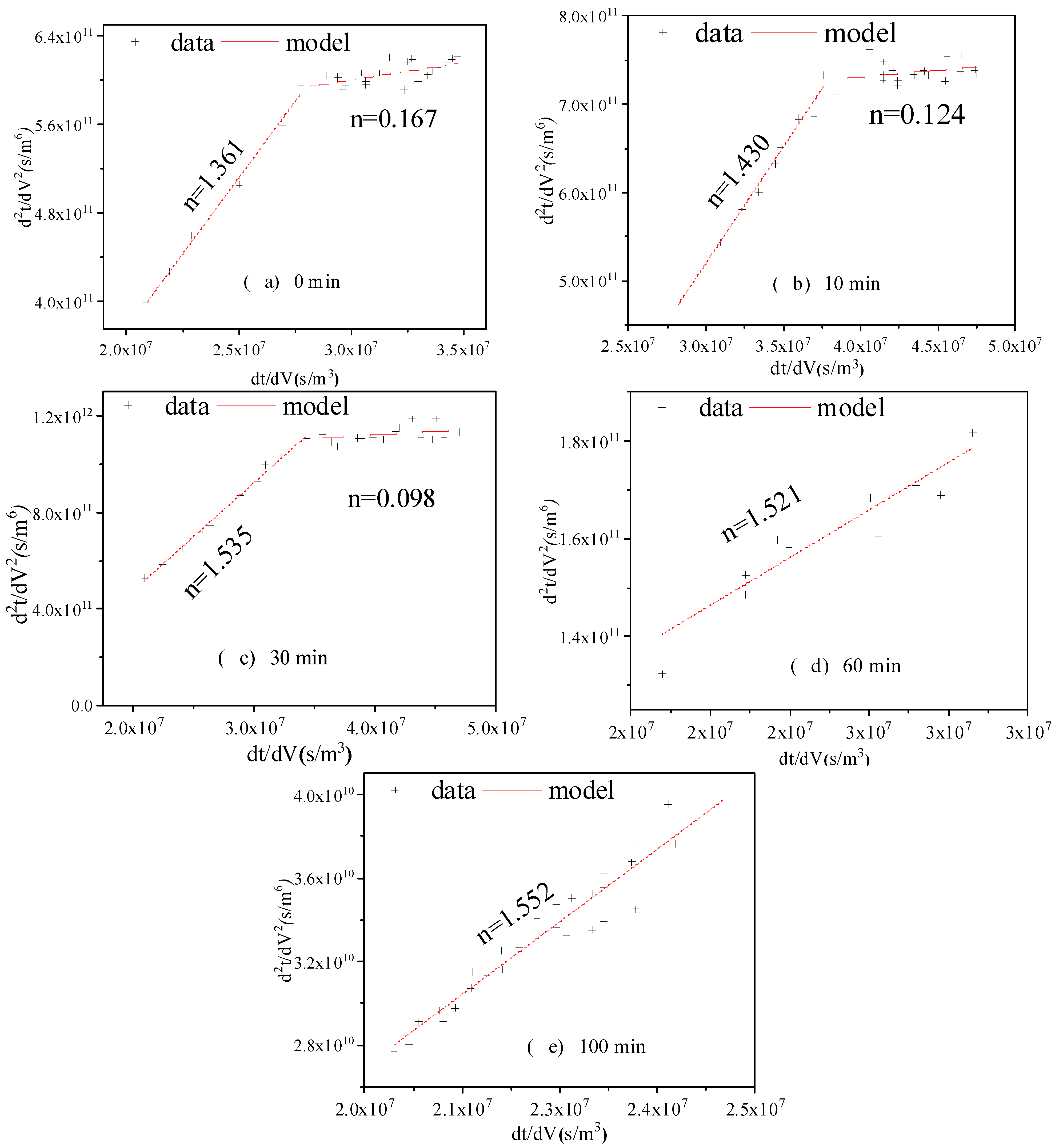
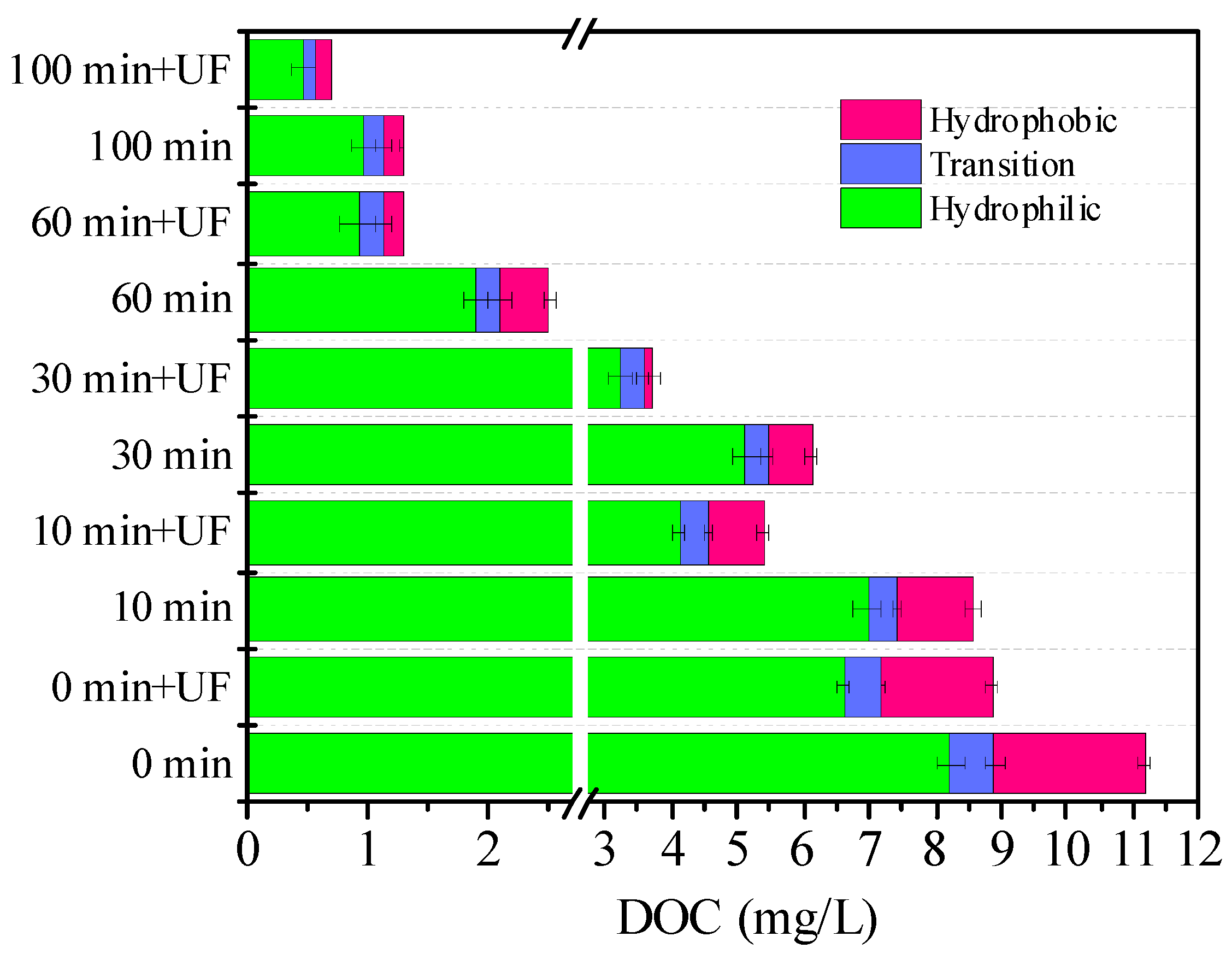
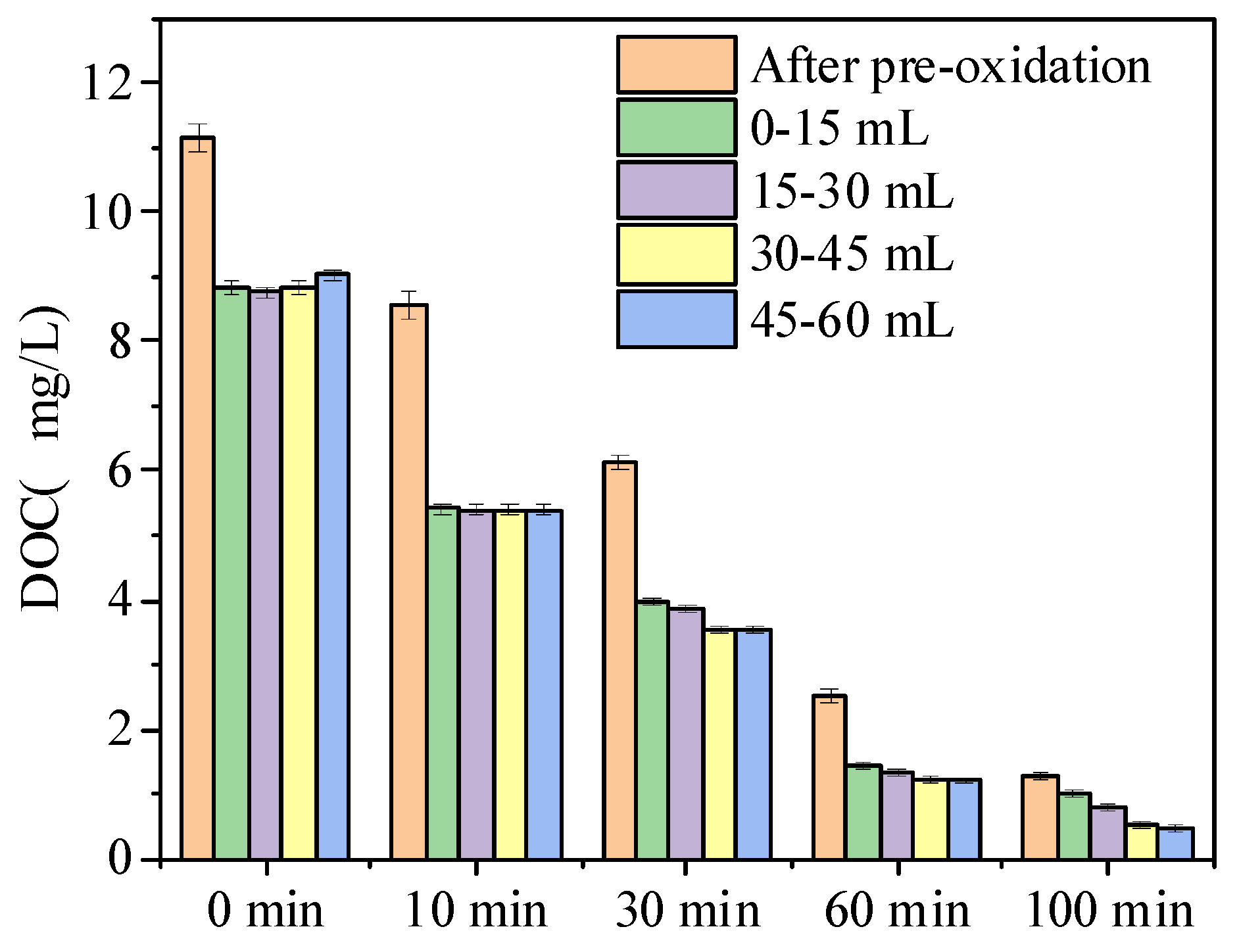
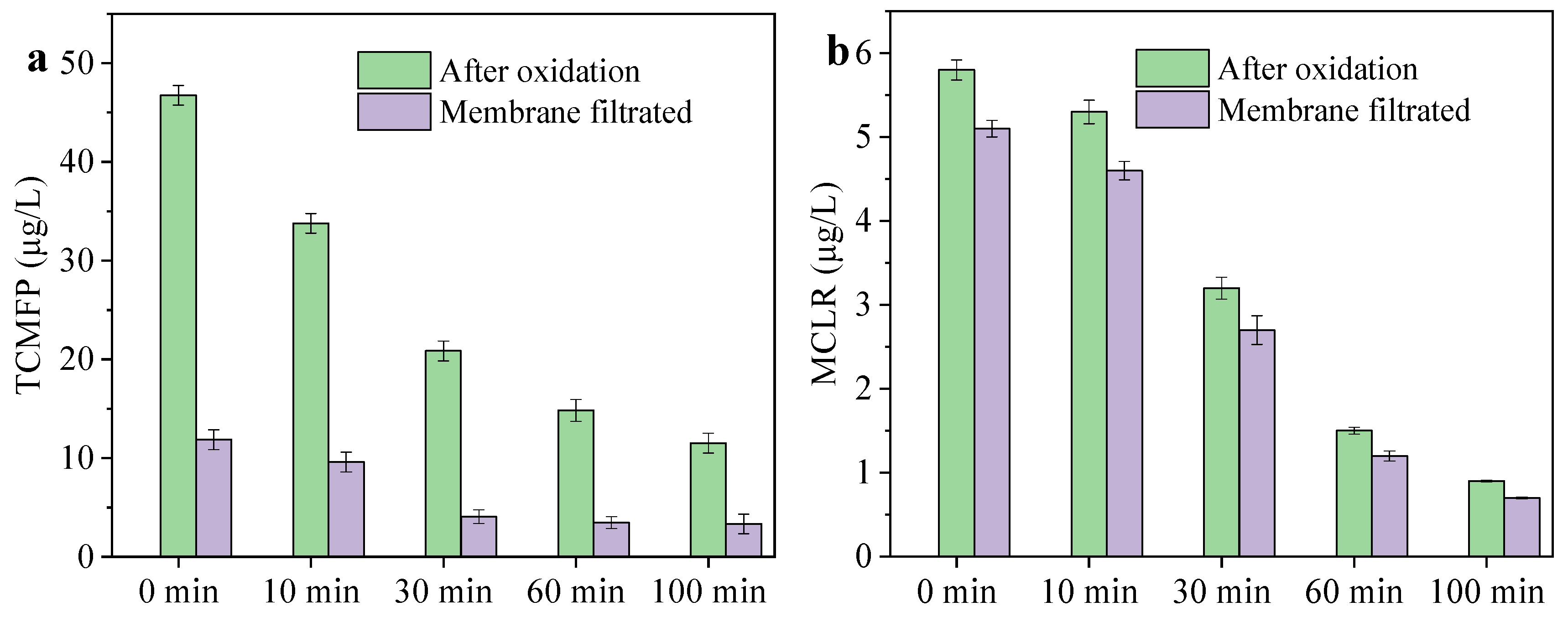
| Fouling Model | Equation | n |
|---|---|---|
| Cake layer filtration | 0 | |
| Critical blocking | 1 | |
| Standard blocking | 1.5 | |
| Complete blocking | 2 |
| Pre-Oxidation Time | Zeta Potential |
|---|---|
| 0 min | −19.1 mV |
| 10 min | −18.6 mV |
| 30 min | −17.8 mV |
| 60 min | −15.4 mV |
| 100 min | −14.9 mV |
| 0 min | 10 min | 30 min | 60 min | 100 min | ||
|---|---|---|---|---|---|---|
| Cohesive free energy | −16.32 | −15.85 | −12.67 | −6.57 | −6.11 | |
| Adhesive free energy | −68.65 | −51.33 | −32.22 | −18.67 | −9.16 |
Disclaimer/Publisher’s Note: The statements, opinions and data contained in all publications are solely those of the individual author(s) and contributor(s) and not of MDPI and/or the editor(s). MDPI and/or the editor(s) disclaim responsibility for any injury to people or property resulting from any ideas, methods, instructions or products referred to in the content. |
© 2023 by the authors. Licensee MDPI, Basel, Switzerland. This article is an open access article distributed under the terms and conditions of the Creative Commons Attribution (CC BY) license (https://creativecommons.org/licenses/by/4.0/).
Share and Cite
Xu, S.; Li, G.; Zhou, S.; Shi, Z.; Liu, B. Effect of Electrochemical Pre-Oxidation for Mitigating Ultrafiltration Membrane Fouling Caused by Extracellular Organic Matter. Water 2023, 15, 2235. https://doi.org/10.3390/w15122235
Xu S, Li G, Zhou S, Shi Z, Liu B. Effect of Electrochemical Pre-Oxidation for Mitigating Ultrafiltration Membrane Fouling Caused by Extracellular Organic Matter. Water. 2023; 15(12):2235. https://doi.org/10.3390/w15122235
Chicago/Turabian StyleXu, Shunkai, Guangchao Li, Shiqing Zhou, Zhou Shi, and Bin Liu. 2023. "Effect of Electrochemical Pre-Oxidation for Mitigating Ultrafiltration Membrane Fouling Caused by Extracellular Organic Matter" Water 15, no. 12: 2235. https://doi.org/10.3390/w15122235
APA StyleXu, S., Li, G., Zhou, S., Shi, Z., & Liu, B. (2023). Effect of Electrochemical Pre-Oxidation for Mitigating Ultrafiltration Membrane Fouling Caused by Extracellular Organic Matter. Water, 15(12), 2235. https://doi.org/10.3390/w15122235









